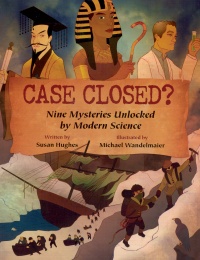| ________________
CM . . .
. Volume XVII Number 13. . . .November 26, 2010 
 |
Case Closed? Nine Mysteries Unlocked by Modern Science.
Susan Hughes. Illustrated by Michael Wandelmaier.
Toronto, ON: Kids Can Press, 2010.
88 pp., hardcover, $18.95.
ISBN 978-1-55453-362-6.
Subject Headings:
History-Miscellanea-Juvenile literature.
Technological innovations-Juvenile literature.
Grade 3-7 / Ages 8-12.
Review by Barbara McMillan.
**** /4 |
| |
|

excerpt:
Missing: Sir John Franklin Ė explorer
Date last Seen: 1845
Place last seen: Melville Bay, Arctic
The disappearance of Franklin and his ships prompted a landslide of search-and-rescue missions. Over thirty expeditions tried to find evidence of the missing men. In fact, more ships and men were lost looking for Franklin that we lost in Franklinís expedition itself!
In May 1858, members of the Fox expedition, privately funded by John Franklinís widow, found signs of a hunting or observatory camp on King William Island. They discovered a skeleton and, under a rock cairn, two notes on a piece of paper in a cylinder, the only written record that has ever been found of Franklinís voyage.
What had become of Sir John Franklin and his crew? Would their bodies or their ships ever be found?
The story of Sir John Franklinís disappearance is one of nine similar mysteries in Susan Hughesí newest book, Case Closed?. Each mysterious case, whether an ancient or 20th century incident, is thoughtfully presented in rich historical detail, and the solution or probable explanation for each mysterious disappearance is accurately described and attributed to the use of traditional and modern scientific techniques and technological tools. It is this combination of unsolved historical events with scientific and technological evidence that makes the book so compelling and unique.
The cases are presented chronologically. The first begins in Ancient Egypt with the disappearance of Hatshepsut, a powerful female pharaoh who ruled for 22 years and then disappeared. This is followed by the case of Hsu Fu, a Buddhist monk and mariner, who was sent by a Chinese emperor to locate and obtain a plant that would bestow eternal life. He was last seen alive in China around 215 bce. Readers then learn about the lost City of Ubar in the southern part of the Arabian Peninsula that disappeared around 300 ce, the sudden disappearance of the Anasazi people from the American southwest around 1300 ce, and John Franklinís doomed expedition to find the Northwest Passage. The final four mysterious cases occurred in the 20th century and focus on the missing Russian princess Anastasia, the disappearance of mountain climber George Mallory during a 1924 expedition to the summit of Mount Everest, the airliner Star Dust that vanished during a 1947 flight from London, England, to Santiago, Chile, and the Israeli submarine INS Dakar that disappeared without a trace in 1968 while crossing the Mediterranean Sea.
Each case is explored in a distinctive manner by researchers who were determined to bring closure to the mysterious disappearance. As two examples, Egyptian archaeologist Dr. Zahi Hawass used computerized axial tomography (CAT) scans of four female mummies and a tooth believed to belong to Hatshepsut to determine that one of these mummies was, in fact, the Egyptian pharaoh and that she had not been murdered but died of natural causes. Dr. Carlos BauzŠ, Carlos Sorini, and glaciologist Juan Leiva, on the other hand, made use of what they knew of structural damage to airplanes from impacts, mountain avalanches, and meteorological phenomena to determine that the pilots of Star Dust had flown into a jet stream without knowing it. The winds blowing against the plane slowed it down considerably. Given the elapsed time, the pilots thought they had crossed the Andes mountain range and began to descend. Instead, they headed straight toward the mountainside, hit it, and vanished under an avalanche of snow.
Hughes tells each mystery in seven, eight, or ten well-illustrated pages. A few of these illustrations are photographic images and scans from scientific instruments. The most prevalent, informative, and illustrative, however, are those created by Michael Wandelmaier. Whether he presents information in a diagram, a map, a page from a log book, a case file, or a scene imagined from the events presented in Hughesí writing, every image in valuable and brings the story to life.
I highly recommend Case Closed? Nine Mysteries Unlocked by Modern Science. In the 88 pages of the book, Susan Hughes and Michael Wandelmaier have captured what drives scientists, archeologists, forensic anthropologists, and history buffs to undertake the work that they do. The nine cases will certainly capture the imagination of readers who like mysteries and the variety of ways in which mysteries can be solved using the processes of science and technological tools, both ancient and modern.
Highly Recommended.
Barbara McMillan is a teacher educator and a professor of science education in the Faculty of Education, the University of Manitoba, in Winnipeg, MB.
 To comment
on this title or this review, send mail to cm@umanitoba.ca.
To comment
on this title or this review, send mail to cm@umanitoba.ca.
Copyright © the Manitoba Library Association. Reproduction for personal
use is permitted only if this copyright notice is maintained. Any
other reproduction is prohibited without permission.
NEXT REVIEW |
TABLE OF CONTENTS FOR THIS ISSUE
- November 26, 2010.
AUTHORS |
TITLES |
MEDIA REVIEWS |
PROFILES |
BACK ISSUES |
SEARCH |
CMARCHIVE |
HOME |
|
